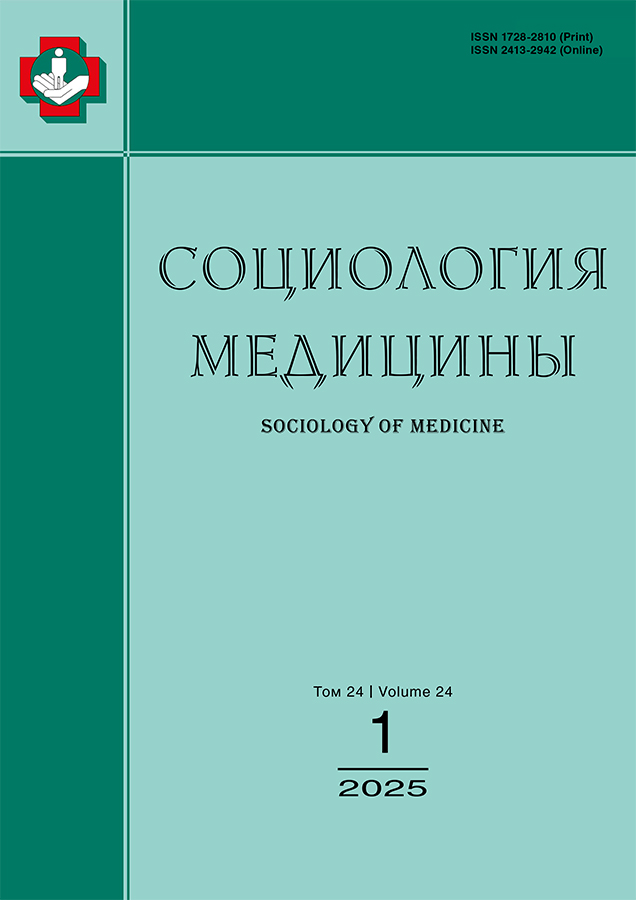Risky sexual behavior of Belarusian adolescents: ten-year dynamics and comparison with foreign data
- Authors: Surmach M.Y.1, Yazepchyk O.A.1
-
Affiliations:
- Grodno State Medical University
- Issue: Vol 24, No 1 (2025)
- Pages: 5-14
- Section: MEDICAL SOCIOLOGICAL STUDIES
- URL: https://rjsocmed.com/1728-2810/article/view/643489
- DOI: https://doi.org/10.17816/socm643489
- EDN: https://elibrary.ru/GNINMK
- ID: 643489
Cite item
Abstract
BACKGROUND: In the context of depopulation, the problem of risky sexual behavior among adolescents represents a potential demographic threat to the Republic of Belarus and, therefore, requires thorough investigation.
AIM: To characterize the sexual behavior of Belarusian adolescents aged 15–18 over the last 10–15 years and compare these data with foreign studies.
Materials and METHODS: The survey was conducted on a quota-based national sample of adolescents (n=1254) aged 15–18 years from November 01, 2022, to May 31, 2023. The database was developed and registered as a copyrighted work. A comparison was made with a similar study conducted in 2010–2011 (n=949). To compare with foreign data, materials from the Health Behavior of School-Age Children project, conducted by the World Health Organization (WHO) in 2021–2022 across 42 countries in Europe, Central Asia, and Canada, were used.
RESULTS: Belarusian adolescents become sexually active one year later than their foreign peers. At age 15, one in 13 boys and one in 17 girls report sexual activity, compared with one in five boys and one in seven girls abroad. By age 16, one in five girls and one in four boys are sexually active. By age 17, the proportion of sexually experienced young men is significantly higher.
International data show differences between regions and countries. For Belarus, the influence of the residence factor has not been established.
The majority of sexually active adolescents consider adolescence to be the optimal age for initiation, indicating a lack of understanding of the risks. Similar to their foreign peers, one in three Belarusian adolescents report that they did not use contraception during their last sexual intercourse.
Belarusian young men, like their foreign peers, show a significantly higher risk of casual sexual relations, regardless of their place of residence. The comparison of data from 2010–2011 and 2022–2023 shows that young people choose unverified sources of information about sexual relations. These trends, therefore, cannot be characterized as positive.
CONCLUSION: Despite much more favorable data in comparison with the countries of Western Europe, Asia, and Canada, as well as some positive shifts observed between 2010 and 2023, the sexual behavior of Belarusian adolescents still remains risky for their health and future reproductive potential.
Full Text
About the authors
Marina Y. Surmach
Grodno State Medical University
Author for correspondence.
Email: marina_surmach@mail.ru
ORCID iD: 0000-0002-3653-8385
SPIN-code: 3697-5235
MD, Dr. Sci. (Medicine), Professor
Belarus, GrodnoOksana A. Yazepchyk
Grodno State Medical University
Email: yazepchyk87@mail.ru
ORCID iD: 0000-0003-4049-8061
SPIN-code: 5429-8708
Belarus, Grodno
References
- Inchley J, Currie D, Budisavljevic S, et al., editors. Spotlight on adolescent health and well-being. Findings from the 2017/2018 Health Behaviour in School-aged Children (HBSC) survey in Europe and Canada. International report. Vol. 1. Key Findings [Internet]. Copenhagen: WHO Regional Office for Europe; 2020 [cited 2025 February 9]. Available from: https://iris.who.int/bitstream/handle/10665/332091/9789289055000-eng.pdf
- Guzik EO. Hygienic basis of formation of health of students in general secondary education institutions [dissertation abstract]. Minsk, 2021. 52 p. (In Russ.)
- Yazepchyk OA, Surmach MYu. Gender and place-of-residence specific features of morbidity among adolescents in the Republic of Belarus. Voprosy organizatsii i informatizatsii zdravookhraneniya. 2024;4:53–61. (In Russ.) EDN: NCQQIO
- Cosma A, Abdrakhmanova S, Taut D, et al. A focus on adolescent mental health and well-being in Europe, central Asia and Canada Health Behaviour in School-aged Children international report from the 2021/2022 survey. Vol. 1 [Internet]. Copenhagen: WHO Regional Office for Europe; 2023 [cited 2025 February 9]. Available from: https://iris.who.int/bitstream/handle/10665/373201/9789289060356-eng.pdf?sequence=2&isAllowed=y
- Eriksson C, Boniel-Nissim M, Lyyra N, et al. A network of care: the importance of social support for adolescents in the WHO European Region during the COVID-19 pandemic. Impact of the COVID-19 pandemic on young people’s health and well-being from the findings of the HBSC survey round 2021/2022 [Internet]. Copenhagen: WHO Regional Office for Europe; 2023 [cited 2025 February 9]. Available from: https://iris.who.int/bitstream/handle/10665/369716/WHO-EURO-2023-7744-47512-69873-eng.pdf?sequence=2
- Cosma A, Molcho M, Pickett W. A focus on adolescent peer violence and bullying in Europe, central Asia and Canada Health Behaviour in School-aged Children international report from the 2021/2022 survey. Vol. 2 [Internet]. Copenhagen: WHO Regional Office for Europe; 2024 [cited 2025 February 9]. Available from: https://iris.who.int/bitstream/handle/10665/376323/9789289060929-eng.pdf?sequence=2&isAllowed=y
- Rakić JG, Hamrik Z, Dzielska A, et al. A focus on adolescent physical activity, eating behaviours, weight status and body image in Europe, central Asia and Canada Health Behaviour in School-aged Children international report from the 2021/2022 survey. Vol. 4 [Internet]. Copenhagen: WHO Regional Office for Europe; 2024 [cited 2025 February 9]. Available from: https://iris.who.int/handle/10665/376772
- Költő A, de Looze M, Jаstad A, et al. A focus on adolescent sexual health in Europe, central Asia and Canada. Health Behaviour in School-aged Children international report from the 2021/2022 survey. Vol. 5 [Internet]. Copenhagen: WHO Regional Office for Europe; 2024. [cited 2024 November 8]. Available from: https://iris.who.int/bitstream/handle/10665/378547/9789289061155-eng.pdf?sequence=1
- Zhuravleva IV, Ivanova LYu, Ivakhnenko GA, et al. Health of adolescents and the environment: changes over 20 years. Zhuravleva IV, editor [Internet]. Moscow: FCTAS RAS; 2021 [cited 2025 February 9]. 309 p. Available from: https://www.fnisc.ru/publ.html?id=9847 (In Russ.) doi: 10.19181/monogr.978-5-89697-356-0.2021
- Yazepchyk OA, Surmach MYu. “Health-oriented model of behavior of adolescents in the republic of Belarus”: research design. Voprosy organizatsii i informatizatsii zdravookhraneniya. 2024;1:51–61. (In Russ.) EDN: UKZFXM
- Surmach MYu. Quality of life of adolescents in the Republic of Belarus: connection with health. Grodno: GrGMU; 2013. 227 p. (In Russ.) EDN: SBFIDJ
Supplementary files







